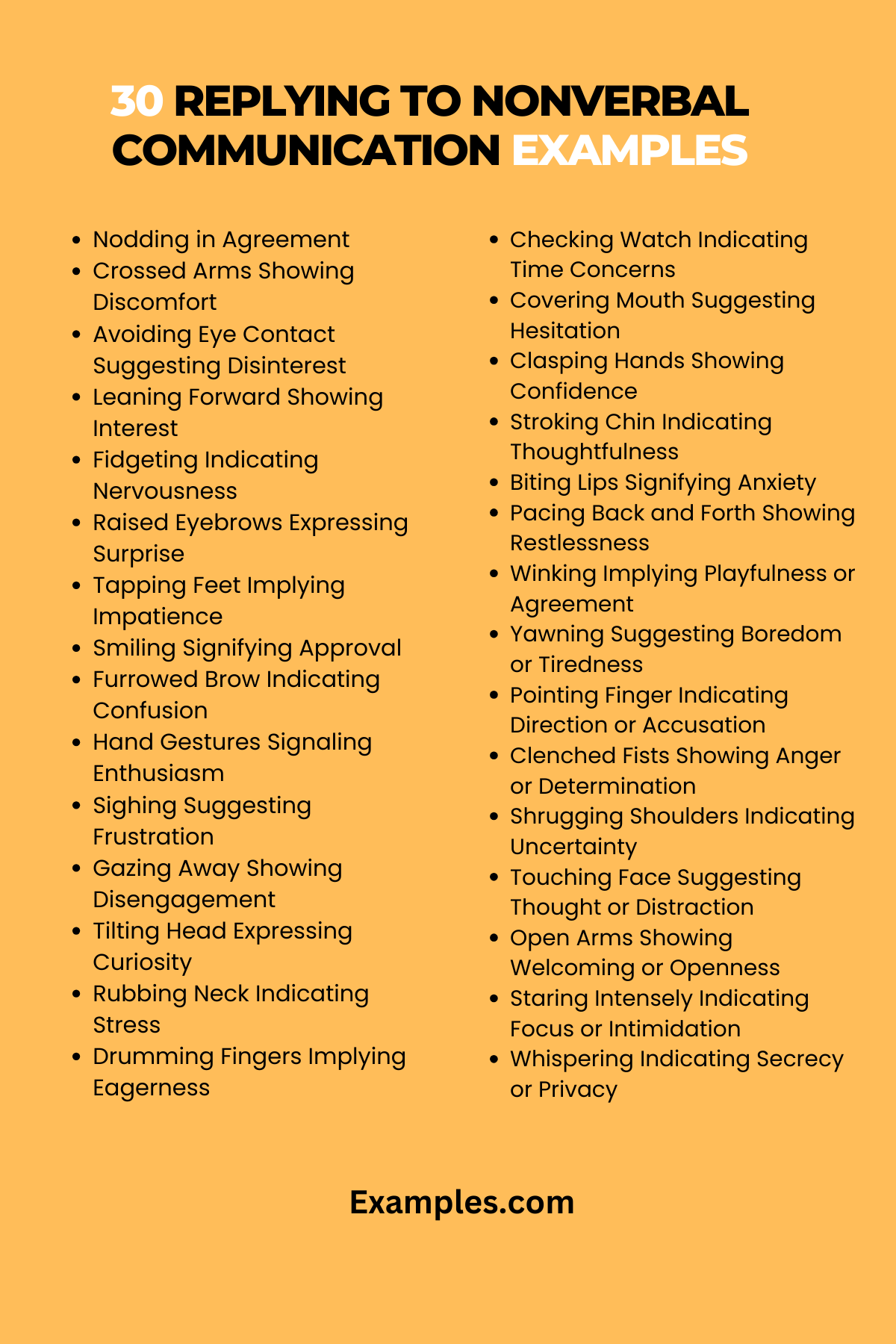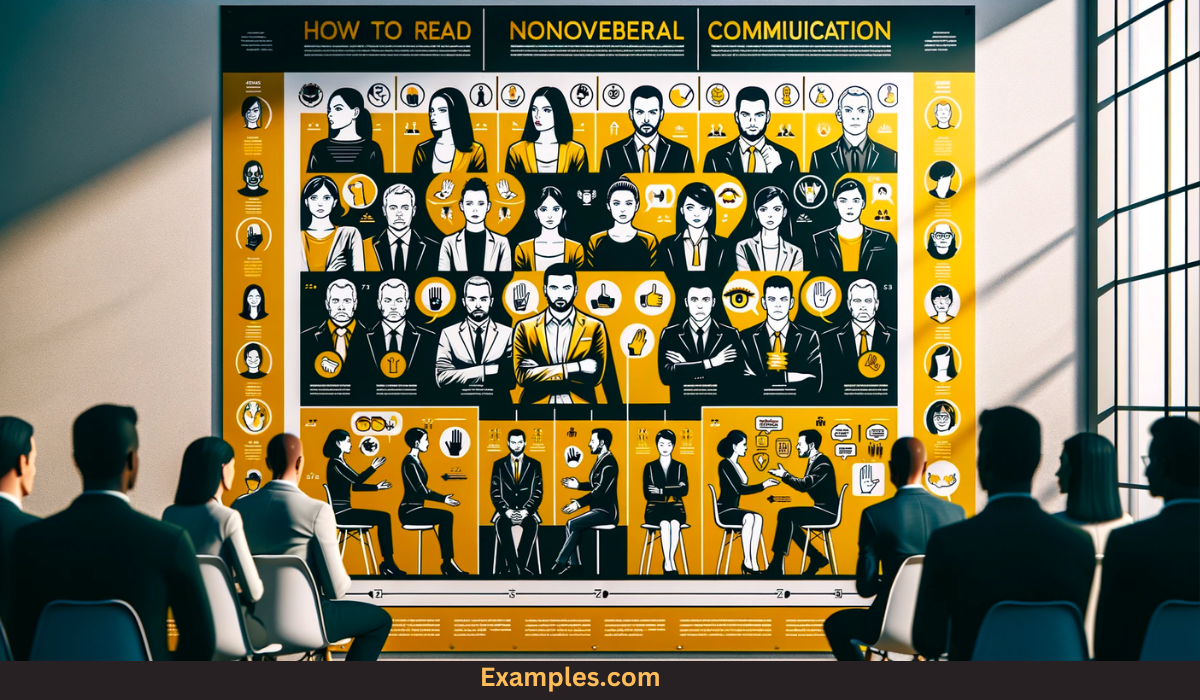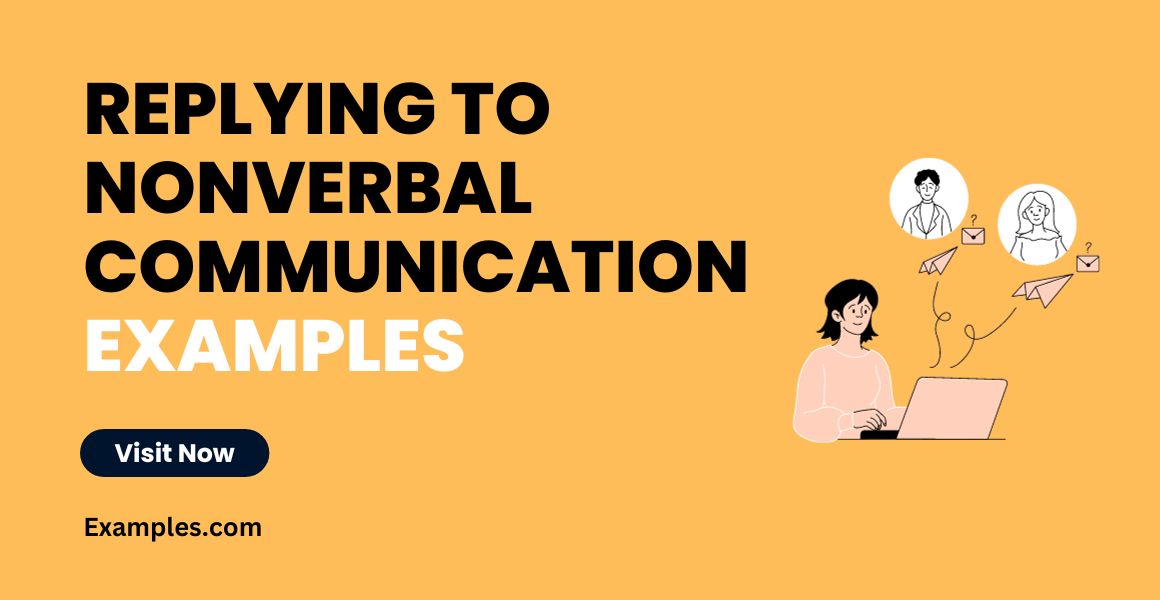29+ Replying to Nonverbal Communication Examples
In this comprehensive guide, we delve into the realm of replying to nonverbal communication, a vital aspect of our daily interactions. Understand the subtle art of interpreting gestures, facial expressions, and other silent messages through illustrative nonverbal communication examples. Enhance your ability to respond effectively, fostering clearer and more empathetic connections. Whether in personal or professional contexts, mastering nonverbal cues is an invaluable skill for successful communication.
30 Replying to Nonverbal Communication Examples
Understanding and effectively replying to nonverbal communication is a crucial skill in both personal and professional realms. This section provides 30 unique and insightful examples, each accompanied by a brief explanation and example sentences, demonstrating how to interpret and respond to various nonverbal cues. These examples cover a wide range of scenarios, offering practical advice for enhancing your nonverbal communication skills.

- Nodding in Agreement: When someone nods, it often indicates agreement or understanding. To respond, you might say, “I see you agree. Let’s move forward with this plan.” This acknowledges their nonverbal cue and reinforces mutual understanding.
- Crossed Arms Showing Discomfort: If someone crosses their arms, they might feel defensive or uncomfortable. A good response could be, “I sense some hesitation. Would you like to discuss any concerns?” This opens the door for verbal communication.
- Avoiding Eye Contact Suggesting Disinterest: When a person avoids eye contact, it may signal disinterest or discomfort. Respond by gently probing, “I notice you seem a bit distant. Is there something on your mind?” This shows empathy and invites sharing.
- Leaning Forward Showing Interest: If someone leans forward, they are likely engaged and interested. You can respond with, “Your engagement is encouraging. Let’s explore this idea further.” This recognizes and appreciates their interest.
- Fidgeting Indicating Nervousness: Fidgeting often signifies nervousness. A reassuring response could be, “I see you’re a bit anxious. Let’s take this step by step.” Offering comfort can ease their tension.
- Raised Eyebrows Expressing Surprise: Raised eyebrows usually indicate surprise or disbelief. You might respond with, “Your reaction suggests surprise. Let me clarify further.” This acknowledges their feeling and provides more information.
- Tapping Feet Implying Impatience: Tapping feet can be a sign of impatience. A possible response is, “I notice you’re in a hurry. I’ll make this quick.” This shows respect for their time.
- Smiling Signifying Approval: A smile generally shows approval or happiness. In response, you could say, “Your smile tells me you’re pleased with this. It’s great to see!” This positive reinforcement can strengthen rapport.
- Furrowed Brow Indicating Confusion: A furrowed brow often means confusion. You could respond by asking, “I see you might be confused. Can I explain anything further?” This invites clarification and understanding.
- Hand Gestures Signaling Enthusiasm: Energetic hand gestures usually convey enthusiasm. A good response is, “Your enthusiasm is evident. Let’s harness this energy!” This capitalizes on their positive momentum.
- Sighing Suggesting Frustration: A sigh might indicate frustration or exhaustion. You can respond with, “I hear a sigh. Is there something frustrating you?” This shows concern and a willingness to listen.
- Gazing Away Showing Disengagement: When someone gazes away, they might be disengaged. Respond by re-engaging them, “It seems you’re distracted. Is there a way to bring you back into this discussion?” This helps refocus the conversation.
- Tilting Head Expressing Curiosity: A tilted head can signal curiosity. An appropriate response is, “Your curiosity is intriguing. What are your thoughts on this matter?” This encourages them to share their perspective.
- Rubbing Neck Indicating Stress: Rubbing the neck often signals stress or tension. A soothing response might be, “I see some tension. Shall we take a brief break?” Offering a break can alleviate stress.
- Drumming Fingers Implying Eagerness: Drumming fingers usually shows eagerness or impatience. You can say, “Your eagerness is apparent. Let’s dive into the details.” This channels their eagerness constructively.
- Checking Watch Indicating Time Concerns: If someone frequently checks their watch, they’re likely concerned about time. Respond by acknowledging, “I notice the time is a concern. Let’s prioritize the key points.” This shows respect for their schedule.
- Covering Mouth Suggesting Hesitation: Covering the mouth can indicate hesitation or uncertainty. A gentle probe could be, “You seem hesitant. Is there something you’re unsure about?” This invites them to express their doubts.
- Clasping Hands Showing Confidence: Clasping hands often reflects confidence or determination. In response, you might say, “Your confidence is inspiring. How can we use this to our advantage?” This leverages their positive attitude.
- Stroking Chin Indicating Thoughtfulness: Stroking the chin usually signals deep thought. Respond with, “You’re in deep thought. What insights do you have?” This values their contemplative approach.
- Biting Lips Signifying Anxiety: Biting lips can signify anxiety or uncertainty. A reassuring response might be, “I notice some anxiety. Remember, we’re in this together.” Offering support can reduce their anxiety.
- Pacing Back and Forth Showing Restlessness: Pacing can indicate restlessness or anxiety. To respond, you could say, “Your pacing suggests restlessness. How can we address this?” This shows awareness and a desire to help.
- Winking Implying Playfulness or Agreement: A wink often conveys playfulness or agreement. You might playfully respond, “Got your wink. We’re on the same page!” This acknowledges the gesture in a light-hearted way.
- Yawning Suggesting Boredom or Tiredness: Yawning can signal boredom or tiredness. A considerate response is, “You seem tired. Let’s take a quick break.” This shows care for their well-being.
- Pointing Finger Indicating Direction or Accusation: Pointing a finger can mean direction or accusation. A diplomatic response could be, “I see your point. Let’s focus on finding solutions.” This redirects the conversation positively.
- Clenching Fists Showing Anger or Determination: Clenched fists can signal anger or determination. A calm response is, “I notice some strong feelings. Let’s discuss this openly.” This encourages a constructive dialogue.
- Shrugging Shoulders Indicating Uncertainty: A shrug typically suggests uncertainty or indifference. You could respond with, “Your shrug tells me you’re unsure. Can I provide more clarity?” This offers further explanation.
- Touching Face Suggesting Thought or Distraction: Touching the face often indicates deep thought or distraction. A focused response might be, “You seem distracted. Is there something else on your mind?” This seeks to understand their state of mind.
- Open Arms Showing Welcoming or Openness: Open arms usually signify a welcoming attitude or openness. A positive response is, “Your open arms show readiness. Let’s embrace this opportunity.” This mirrors their openness.
- Staring Intensely Indicating Focus or Intimidation: Intense staring can convey focus or intimidation. A balanced response could be, “Your intense gaze shows focus. Let’s ensure we’re aligned on this.” This acknowledges their concentration.
- Whispering Indicating Secrecy or Privacy: Whispering usually suggests a need for secrecy or privacy. In response, you might say, “I see we need privacy. Let’s discuss this privately.” This respects their need for discretion.
How to Respond to Nonverbal Communication?
Responding effectively to nonverbal communication requires a keen observation and understanding of the subtle cues people exhibit. The key is to interpret these cues within the context they are presented. For instance, a nod might indicate agreement, while crossed arms could suggest resistance or discomfort. The response should be empathetic and tailored to the observed cue. For example, if someone appears closed-off, asking open-ended questions can encourage them to open up. It’s also essential to match your nonverbal responses with verbal communication, ensuring consistency and clarity in your interactions. By attentively observing and thoughtfully responding to these nonverbal signals, you can greatly enhance the quality of your communication.
Understand and Respond to Nonverbal Communication
Understanding nonverbal communication involves more than just recognizing different physical cues. It encompasses an awareness of cultural, contextual, and individual differences that influence how nonverbal cues are expressed and interpreted. To effectively understand and respond, one must consider the entire communication environment. This includes recognizing the potential for misinterpretation due to cultural differences, being aware of personal biases, and considering the context in which the interaction occurs. Active listening plays a crucial role here, as it involves not only hearing the words spoken but also paying attention to the accompanying nonverbal messages. The goal is to create a complete picture of the communicator’s intent and emotions, enabling a more accurate and empathetic response.
How to Read Nonverbal Communication?
Reading nonverbal communication effectively is an art that requires practice and attention to detail. It involves observing cues such as facial expressions, body language, gestures, eye contact, and tone of voice. Each of these elements can offer insights into a person’s feelings and intentions. For instance, a person’s posture can reveal confidence or insecurity, while eye contact can indicate honesty or avoidance. It’s important to remember that nonverbal cues can vary significantly across different cultures and individuals. Therefore, interpreting these signals should be done cautiously and in context. By improving your ability to read nonverbal communication, you can gain a deeper understanding of others, paving the way for more meaningful and effective interactions.

In conclusion, mastering the art of responding to nonverbal communication is crucial. Recognizing cues of nonverbal communication, such as body language, facial expressions, and gestures, enhances understanding and builds stronger connections. This guide offers valuable tips for interpreting these cues effectively, enabling better, more empathetic responses in various interactions. Remember, nonverbal cues often speak louder than words.



